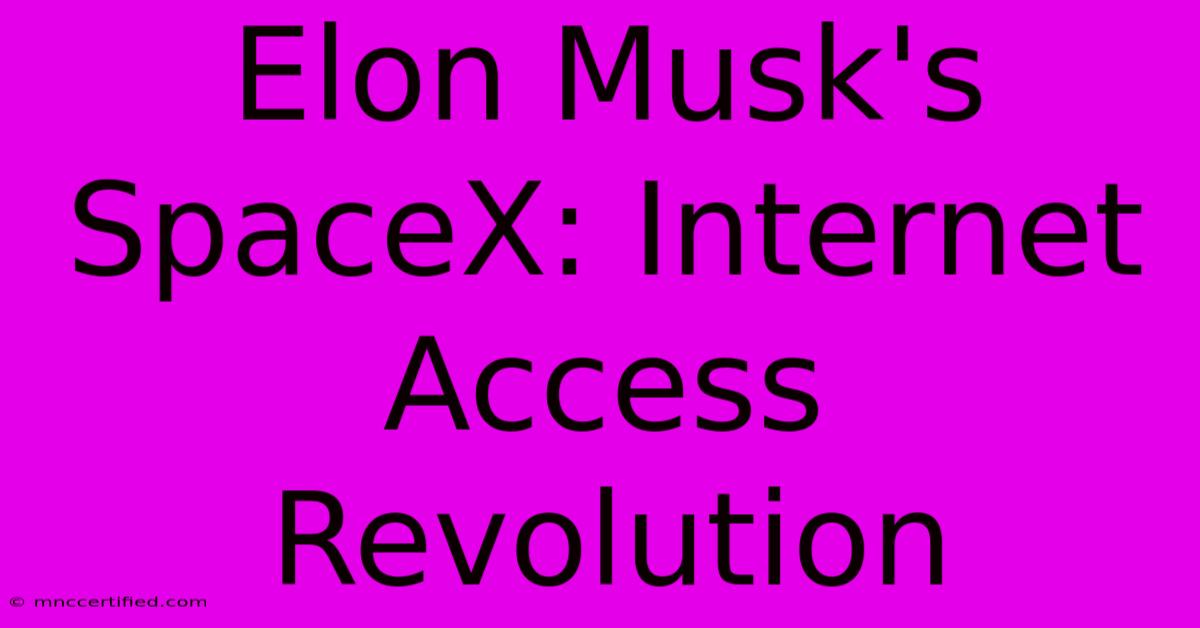Elon Musk's SpaceX: Internet Access Revolution

Table of Contents
Elon Musk's SpaceX: Revolutionizing Internet Access with Starlink
Elon Musk's SpaceX has made significant strides in the realm of internet access with its ambitious Starlink project. This constellation of thousands of low Earth orbit (LEO) satellites aims to deliver high-speed, low-latency internet to underserved areas around the globe. This article delves into the revolutionary potential of Starlink, exploring its benefits, challenges, and impact on the future of internet connectivity.
The Starlink Revolution: Bringing Connectivity to the Underserved
Starlink's primary mission is to provide affordable and reliable internet access to those who lack it. This includes remote areas, rural communities, and developing countries, often excluded from traditional broadband infrastructure. By leveraging its vast satellite network, Starlink bypasses the need for ground-based infrastructure, offering connectivity in places where laying cables is impractical or prohibitively expensive.
The Advantages of Starlink: Speed, Latency, and Global Reach
Starlink offers several key advantages that set it apart from traditional internet providers:
- High-Speed Connectivity: Starlink boasts download speeds ranging from 50 Mbps to 220 Mbps, capable of supporting various online activities, from streaming and gaming to video conferencing.
- Low Latency: Starlink's LEO satellites significantly reduce latency compared to traditional geostationary satellites, resulting in a more responsive and enjoyable online experience.
- Global Reach: Unlike traditional providers limited by geographical constraints, Starlink's constellation provides internet access to virtually any location on Earth with a clear view of the sky.
Challenges and Considerations
While Starlink holds tremendous potential, it faces several challenges:
- Cost: Starlink's hardware and service subscription costs may be out of reach for some individuals and communities, especially in developing countries.
- Weather Dependence: Adverse weather conditions like heavy rain or snow can interfere with Starlink's signal strength, potentially leading to service interruptions.
- Satellite Congestion: As more satellites are launched, potential congestion could arise, potentially impacting performance and speed.
The Future of Internet Connectivity: Starlink's Impact
Starlink's success could have a transformative impact on the future of internet access:
- Bridging the Digital Divide: Starlink has the potential to bridge the digital divide by providing connectivity to remote and underserved communities, fostering economic growth and social inclusion.
- Boosting Innovation: By offering high-speed and reliable internet access, Starlink can fuel innovation and entrepreneurship in previously unconnected regions.
- Emergency Response: Starlink's satellite network can provide vital communication during natural disasters and emergencies, supporting rescue and relief efforts.
Conclusion: A New Era of Internet Access
Elon Musk's SpaceX, with its innovative Starlink project, is poised to revolutionize internet access. By providing reliable and affordable connectivity to underserved areas, Starlink can empower individuals and communities, fostering economic development, social inclusion, and global progress. While challenges remain, Starlink's potential impact on the future of internet connectivity is undeniable, paving the way for a world where everyone can access the transformative power of the digital age.
Keywords: Starlink, SpaceX, Elon Musk, internet access, satellite internet, LEO, low Earth orbit, remote areas, digital divide, connectivity, high-speed internet, low latency, global reach, challenges, future of internet, innovation, emergency response, technology.

Thank you for visiting our website wich cover about Elon Musk's SpaceX: Internet Access Revolution. We hope the information provided has been useful to you. Feel free to contact us if you have any questions or need further assistance. See you next time and dont miss to bookmark.
Featured Posts
-
Trumps Tweet Boosts Dogecoin Musk Connection
Nov 14, 2024
-
Whoopi Goldbergs Italy Travel Picks
Nov 14, 2024
-
Wembanyamas 50 Points Lead Spurs To Victory
Nov 14, 2024
-
Full Houses Dave Coulier Battles Cancer
Nov 14, 2024
-
Sara Sharif Death Father Accepts Responsibility
Nov 14, 2024